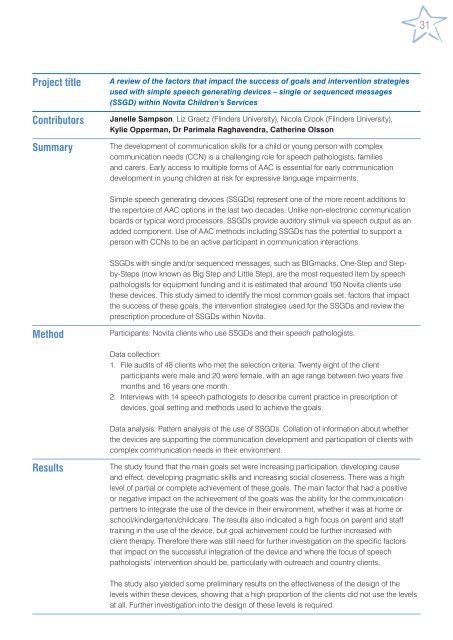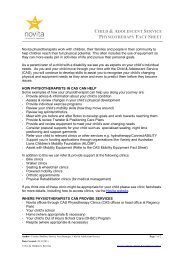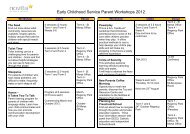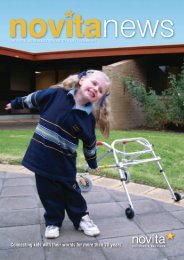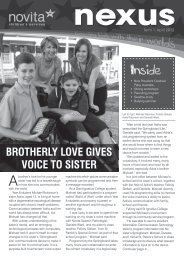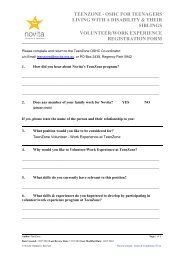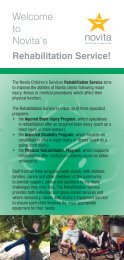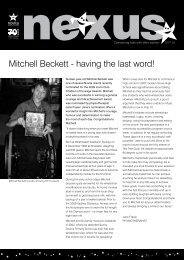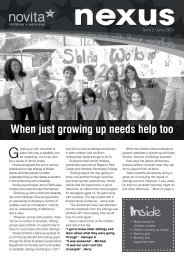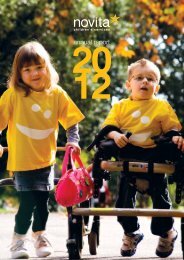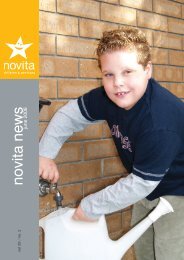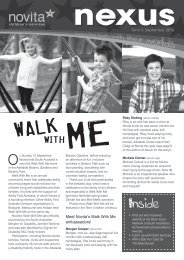Novita Research Report - 2004 to 2007 - Novita Children's Services
Novita Research Report - 2004 to 2007 - Novita Children's Services
Novita Research Report - 2004 to 2007 - Novita Children's Services
- No tags were found...
Create successful ePaper yourself
Turn your PDF publications into a flip-book with our unique Google optimized e-Paper software.
31Project titleContribu<strong>to</strong>rsSummaryA review of the fac<strong>to</strong>rs that impact the success of goals and intervention strategiesused with simple speech generating devices – single or sequenced messages(SSGD) within <strong>Novita</strong> Children’s <strong>Services</strong>Janelle Sampson, Liz Graetz (Flinders University), Nicola Crook (Flinders University),Kylie Opperman, Dr Parimala Raghavendra, Catherine OlssonThe development of communication skills for a child or young person with complexcommunication needs (CCN) is a challenging role for speech pathologists, familiesand carers. Early access <strong>to</strong> multiple forms of AAC is essential for early communicationdevelopment in young children at risk for expressive language impairments.Simple speech generating devices (SSGDs) represent one of the more recent additions <strong>to</strong>the reper<strong>to</strong>ire of AAC options in the last two decades. Unlike non-electronic communicationboards or typical word processors, SSGDs provide audi<strong>to</strong>ry stimuli via speech output as anadded component. Use of AAC methods including SSGDs has the potential <strong>to</strong> support aperson with CCNs <strong>to</strong> be an active participant in communication interactions.SSGDs with single and/or sequenced messages, such as BIGmacks, One-Step and Stepby-Steps(now known as Big Step and Little Step), are the most requested item by speechpathologists for equipment funding and it is estimated that around 150 <strong>Novita</strong> clients usethese devices. This study aimed <strong>to</strong> identify the most common goals set, fac<strong>to</strong>rs that impactthe success of these goals, the intervention strategies used for the SSGDs and review theprescription procedure of SSGDs within <strong>Novita</strong>.MethodParticipants: <strong>Novita</strong> clients who use SSGDs and their speech pathologists.Data collection:1. File audits of 48 clients who met the selection criteria. Twenty eight of the clientparticipants were male and 20 were female, with an age range between two years fivemonths and 16 years one month.2. Interviews with 14 speech pathologists <strong>to</strong> describe current practice in prescription ofdevices, goal setting and methods used <strong>to</strong> achieve the goals.Data analysis: Pattern analysis of the use of SSGDs. Collation of information about whetherthe devices are supporting the communication development and participation of clients withcomplex communication needs in their environment.ResultsThe study found that the main goals set were increasing participation, developing causeand effect, developing pragmatic skills and increasing social closeness. There was a highlevel of partial or complete achievement of these goals. The main fac<strong>to</strong>r that had a positiveor negative impact on the achievement of the goals was the ability for the communicationpartners <strong>to</strong> integrate the use of the device in their environment, whether it was at home orschool/kindergarten/childcare. The results also indicated a high focus on parent and stafftraining in the use of the device, but goal achievement could be further increased withclient therapy. Therefore there was still need for further investigation on the specific fac<strong>to</strong>rsthat impact on the successful integration of the device and where the focus of speechpathologists’ intervention should be, particularly with outreach and country clients.The study also yielded some preliminary results on the effectiveness of the design of thelevels within these devices, showing that a high proportion of the clients did not use the levelsat all. Further investigation in<strong>to</strong> the design of these levels is required.


